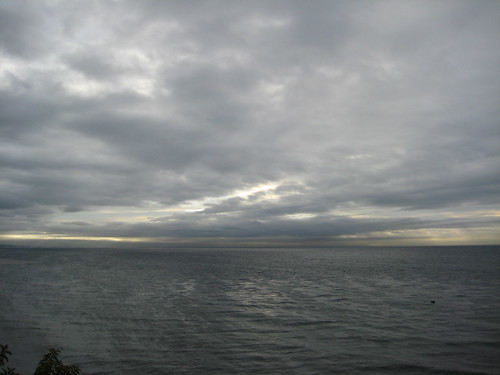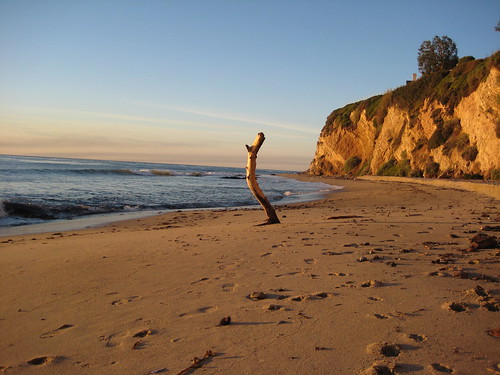
February 27, 2008
It's Maisie, home from charm school. And while that may seem like ho-hum news, what with a tanking real estate market, four-dollar gas and the return of bell bottoms, in some circles (OK, that would be Jake) it was cause for competition celebration.
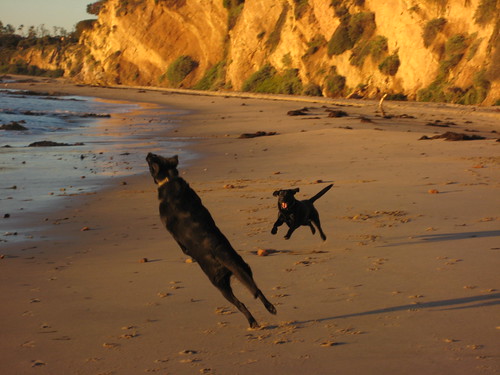
February 26, 2008
It's been a few weeks since I saw the sun rise here in Malibu. There was work, there was rain, and there was work while it rained.
I would have worked right through the sunrise again today except the birds all went a little nuts. Not just the usual early-morning tweets and twitters but full-on arias with rhythm, melody and crescendo, and tiny little diva dresses cut down to there.
Here's what they were serenading, those early birds - rhythm, melody and crescendo out on the horizon, pink and blue and gold, expanding for all to see.
February 24, 2008
A group of egrets has moved into the Cove during this last set of storms. They huddle near the spot where a creeks flows into the sea. In the days right after a rain, the steep dirt road that drops down to the sand is so muddy and slick, the birds have the beach all to themselves.
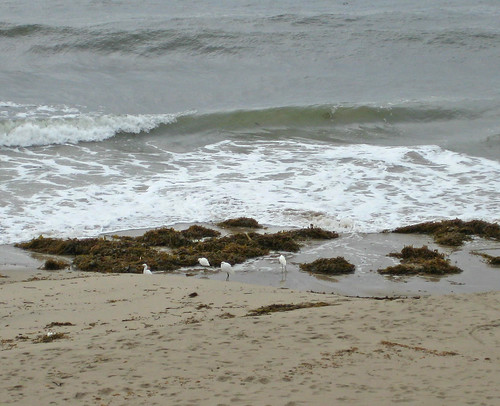
February 22, 2008
February 20, 2008
As long as we're on the subject, here's another dead tree I love. It's on the path to the beach and I think it's the real reason the cat invariably tries to follow us.
She'll trot a few feet behind as we leave the house, dodge in and out of driveways so no one knows she's there. (Except she yowls the entire way so everyone knows she's there.)
When we get to the hill that drops to the fire road, the cat races ahead and flings herself into this tree. She twirls around the trunk, does a few handstands, scrambles up the branches and insists that this, this is the kitty tree we need to bring home, damn it, right now. OK?
February 18, 2008
This is one of my favorite dead trees in the Cove, listing slightly on the path to the beach. It's evolution is slower than that of its living brethren, whose annual budding, leafing, shedding cycles look downright ostentatious next to this tree's slow decay.
Lately though, perhaps thanks to the rains, my favorite dead tree has put on a show. Or put up with a show, since it didn't produce this fungus. But here it is, all color and texture and lovely fuzzy weirdness.
February 15, 2008
Yes, I took this photo to show you the beach today, show you how lovely and amazing it is here on the California coast.
And I took the photo for me, too. I'm in front of a computer for most of the day right now (yep, another blog: LA Now) and I'm beginning to forget, just a little bit, where I live.
Well, here it is. Ahhh...
February 14, 2008
She's gone, our little Miss Maisie, gone back to charm school.
It's not that she isn't charming already, what with that tiny face and those short legs and that stocky little body. But she was getting a bit rusty with the sitting and the staying and the balancing a dictionary on her head, so she's with Kirsten for a little tune-up.
It's nice there, a warm, rambling house filled with dog beds and dog couches and lots of - you guessed it - dogs. And they love Kirsten, treat her like a rock star. When Maisie comes home next week, she'll be back to her well-trained self, good on the leash, wearing white gloves and a little pillbox hat.
So in the meantime, Jake and I hang out, go for walks, revel in the slower pace (he's six, after all) and rely on pix like this to channel the gleeful spirit of the little dog.
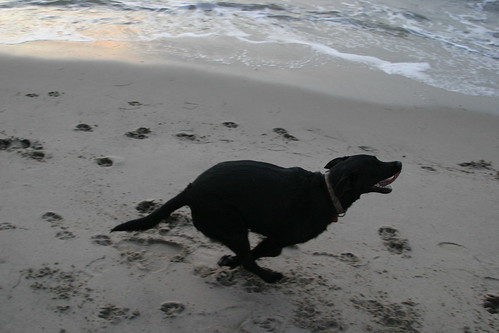
February 13, 2008
OK, one more big-house rant and then I'm done. For a while. For the rest of the week, anyway. But here's another mansion going up on another hilltop here in Malibu and it's hard to watch. More roads, more landscaping, more clearing of important habitat so someone can - what, exactly? What does one family do in 10,000 square feet? Sip Cristal? Swing nude from the chandelier and polish their tiaras?
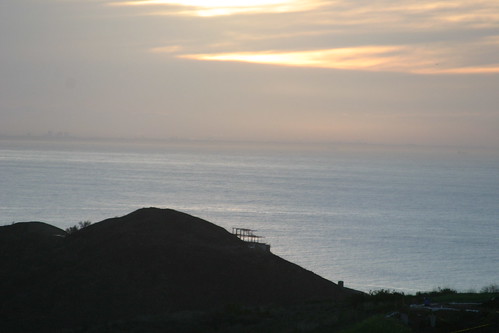
February 12, 2008
Vineyards are popping up all over Malibu these days, from small plantings of just a few rows of vines to enormous enterprises that take up multiple acres. I know, I know, it's nothing compared to the sprawling spreads in Sonoma and Napa, but it's still a shock.
Here's a vineyard that's been taking shape over the last year, the mountaintop lopped off for this modestly-sized home, the surrounding landscape scraped clear of every growing thing to make way for grapes.
Whatever wildlife corridors were once here are gone for good. The bobcats and coyotes, roadrunners and quail, the mountain lions and mule deer, the hawks and owls and kestrels and kites, all the creatures whose home range this was have been forced to move on.
And we who drive over Kanan Road, much of it an uneasy mix of wildnerness and development, get to meditate on hubris and folly.
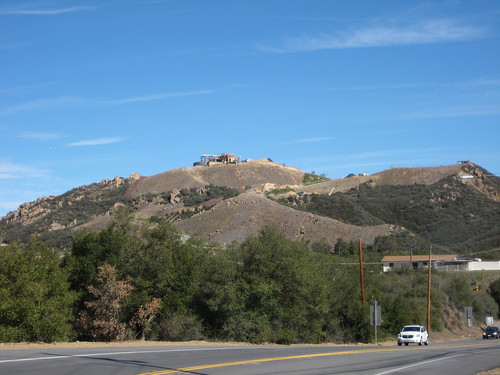
February 11, 2008
When it rained last month, and rained again and then rained some more, a little miracle happened here in Malibu. This triangle of land in the southwest corner of town filled up with water. No surprise, really, as it's a designated flood zone, part of an ancient wetland that, decades ago, got filled in to make solid ground for development.
But now it's been reclaimed by nature. Without a bit of human help, it's a wetland again. Well, biologists might argue it takes more than a persistent puddle to earn that title. Still, here it is, a boggy, marshy stretch where over the weeks we've seen ducks and egrets, herons and hawks who hunt and rest and swim.
It's shrinking, this little wetland, getting smaller as the dry days go by. But right now it looks like this, very real, very right.
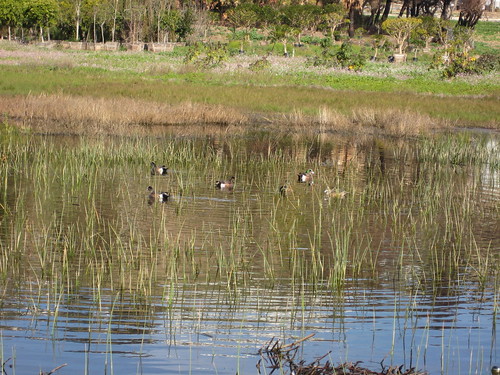
February 7, 2008
A pair of shoes tossed over a telephone wire - urban myth or urban shorthand? Whatever the answer, forget about ratty old Nikes here in Malibu. A pair of money bags, that's how we roll.
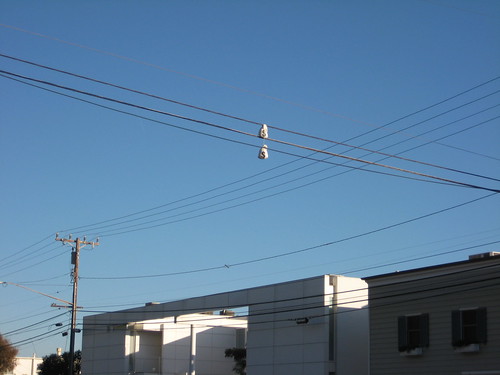
Thank you, Jonah King, for the heads-up.
Remember this? Bluffs Park right after the fire in December 2006.
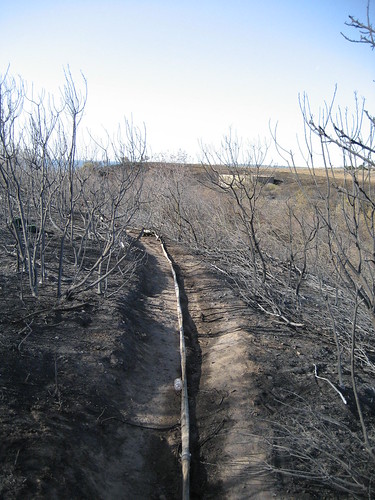
Here it is a bit more than a year - and a few big rainfalls - later:
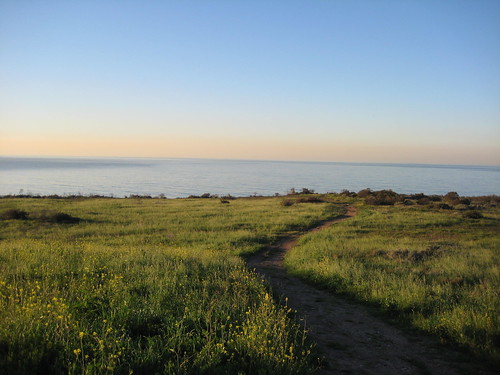
February 6, 2008
Gone.
Here's what's left of Malibu Lumber, the last remaining vestige of Malibu's blue collar past. I said this to one of the workmen as I shot the photo and he snorted at the thought. Malibu, working class? That's a laugh.
But before there were houses here, before there was even a road, long before this little jewel of a spot morphed into its present incarnation as Beverly Hills by the Sea, it was a ranch. (Well, before that, for many centuries, it was a collection of Chumash villages, but anyone who has studied the Mission Period in California history knows how that turned out.)
It took a few decades but the state wrested the Malibu rancho away from May Knight Rindge, derogatorily named "The Queen of the Malibu" by the Santa Monica papers. But she really was a leader, in every good and decent and forward-thinking sense of the term. She fought to keep the Southern Pacific Railroad off her land - outsmarted Collis Huntington himself - and that's why, in all the southern California coast, only this little stretch is free of trains. She fought to keep Pacific Coast Highway off her narrow swathe of land and famously lost that battle. But because she fought, and fought for so long she spent the family fortune, she slowed the tide of development and Malibu stayed rural.
It's only because May lost the fight that any of us get to live here. And as it has since that first Model T lumbered onto the Roosevelt Highway, it's changing. Acreage keeps getting subdivided and those subdivisions get split into ever-smaller plots topped by gigantic, ridiculous houses. A recent buying spree of commercial property by billionaires and mega-corporations has booted out many of our remaining mom'n'pop businesses. And there goes Malibu Lumber, making way for more boutiques, because lord knows we've a shortage of two hundred dollar t-shirts in this town.
People who have lived here far longer than I remember even more about how things used to be, smaller and quieter and not quite so glam. I love to listen to their stories, about how someone grew tomatoes and flowers in what is now the Civic Center, how Sam Peckinpah used to get likkered up and shoot holes in the back wall of his singlewide trailer, or how someone's mother rode her horse to town to get groceries.
I've got to stop now because this is really just the bones of an essay that's been kicking around my head for a while. A lot of it came from my work as a (now lapsed) docent at the Adamson House on the beach here in Malibu, where I recited the rancho's past. Now, across the street from one of Malibu's first beach houses, (which, btw, the state tried to tear down and turn into a parking lot) I watch bulldozers dismantle Malibu Lumber, and listen to contractors say really, it's all for the best.
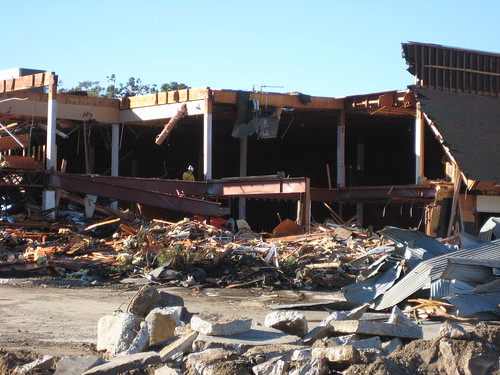
February 5, 2008
After five months on exhibit at the Monterey Bay Aquarium, the great white shark captured off the Malibu coast last summer has been set free.
A young white shark on exhibit at the Monterey Bay Aquarium for the past five months was tagged and returned to the wild shortly after sunrise today (Tuesday, February 5). It marks the third time in four years that the aquarium has exhibited a white shark and then returned it to the wild.(see full text after the jump)
Here are the shark pen and trawler anchored in the Cove last summer, and here's the shark being carried from the water at the Malibu Pier, on its way to being transported to the aquarium.
And here's the Fonz, jumping the shark right next to the Paradise Cove pier.
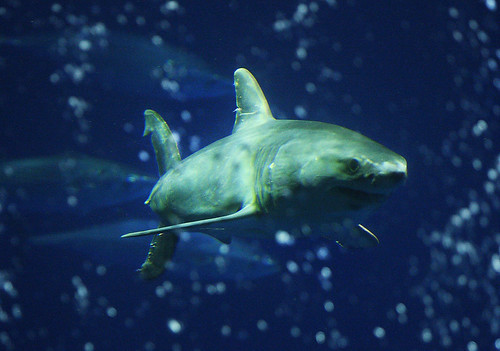
A young white shark on exhibit at the Monterey Bay Aquarium for the past five months was tagged and returned to the wild shortly after sunrise today (Tuesday, February 5). It marks the third time in four years that the aquarium has exhibited a white shark and then returned it to the wild.
Monterey Bay Aquarium remains the only aquarium ever to exhibit the ocean’s top predator for more than 16 days.
Aquarium staff released the male shark from a boat in Monterey Bay after fitting him with two electronic tags: one that will relay near real-time data about his travels for about eight months, and a second that will collect detailed information on his movements for the next five months.
Data from the second tag, documenting where the shark goes, how deep he dives and the water temperatures he favors, will be relayed to scientists via satellite when the tag pops free in early July. Tag data will be posted to the Tagging of Pacific Predators (TOPP) web site, www.topp.org.
The shark had grown from an initial length of 4-foot, 9-inches and a weight of 67 ½ pounds when it arrived on August 28, 2007 to its current size of 5-foot, 10-inches and 140 pounds. He was healthy and feeding at the time of release, but had recently been seen leaping into the air above the million-gallon Outer Bay exhibit where he was housed, said Randy Hamilton vice president of husbandry for the aquarium.
“We were concerned that he was getting a little too frisky for his own good,” Hamilton said. “Since there was a risk of injury if he remained on exhibit, we took it as a signal that it was time to release him.”
“We’ve again learned some new things about caring for white sharks, and we expect he’ll do well after release, just as our first two sharks did,” he added.
In 50 years of attempts by aquariums around the world, this marks only the third time a white shark has survived more than 16 days on exhibit. Similarly, this was only the third white shark to consistently take food offered by aquarium staff.
The first shark in Monterey, a female, was at the aquarium for 198 days in 2004-2005. The second shark, a male, was on exhibit for 137 days.
The latest white shark was seen by more than 650,000 people during its 152 days on exhibit. That was about 8 percent more visitors than aquarium officials had anticipated during the period and slightly below attendance levels for the prior year.
The shark was caught accidentally on August 4, 2007 off Ventura by a commercial fisherman, and held for 24 days in a 4-million-gallon ocean pen off Malibu. He was feeding and navigating the waters of the pen before he was brought to Monterey.
Through its White Shark Research Project, the aquarium has worked since 2002 to learn more about white sharks in the wild and has three times brought a white shark to Monterey for exhibit. During that time, the aquarium and its research partners have tagged and tracked 12 juvenile white sharks off Southern California.
The aquarium has allocated more than $1 million to white shark field research since 2002, with much of the money supporting the tagging of adult white sharks off the Farallon Islands and Point Año Nuevo. Shark researchers with the Tagging of Pacific Predators, led by Dr. Barbara Block and her colleagues at Stanford University’s Hopkins Marine Station, have tracked 143 adult white sharks off the Central Coast using data-collecting tags.
Information from the tags has provided new insights into the far-ranging travels of white sharks in the eastern Pacific, according to Dr. Block, a marine biologist and principal investigator with TOPP.
The aquarium will begin its seventh field season of white shark research this summer, and will again attempt to bring a young shark back to Monterey for exhibit.
Each of the three white sharks brought to Monterey has been “a powerful emissary for ocean conservation,” said aquarium Executive Director Julie Packard. Surveys of aquarium visitors who saw the first white shark found many of them reporting that they came away from the experience with a deeper understanding of the need to protect white sharks and their ocean homes.
During their time at the aquarium, visitors not only see the white sharks, they learn about white shark conservation issues in conversations with staff and volunteer guides, and new exhibit graphics specifically addressing the threats facing white sharks.
Beyond its exhibit program and involvement in white shark field research, the aquarium supports shark conservation through initiatives like Seafood Watch, which creates pocket guides for consumers and education campaigns among restaurateurs and retailers aimed at transforming the seafood market in ways that support sustainable fishing and fish-farming.
Information about the aquarium’s white shark research project and shark conservation initiatives, and an archived webcast interview with white shark experts, is available online at www.montereybayaquarium.org/whiteshark/.
The mission of the Monterey Bay Aquarium is to inspire conservation of the oceans.
February 4, 2008
To everyone who has written in, alarmed that the Plymouth will be eclipsed by that iPod on wheels, the Prius, relax. Not gonna happen. Yes, the Prius is fun to drive, and sure, getting close to 50 miles mpg is a great way to give Big Oil the finger, but bench the Plymouth? I don't think so.
Here's the fine '49er up at the barn this weekend, just hours before this storm system blew through, dumped rain and made mud, forced us indoors to huddle by the fire.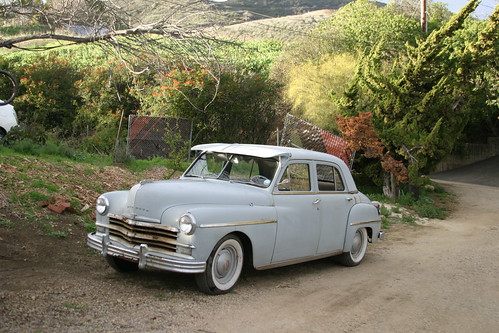
February 1, 2008

|
Media
|
Politics
|
|
|
LA Biz
|
Arts, Books & Food
|
LA Living
|
Sports
|

of LA Observed


